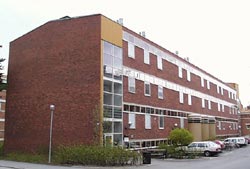Generally
In order to obtain good air quality in the premises, the ventilation is adapted to the number of people and the equipment planned for the rooms. During very hot summer days, the indoor temperature is allowed to rise slightly.
Radiators
The building has radiators for heat and to prevent frostbite.
Radiators in the lab can be controlled manually via a control on the radiator.
Office and meeting room
In offices and meeting rooms, the normal temperature can be slightly influenced via a room regulator inside the door. If you turn the switch towards red it will be warmer and if you turn it towards blue it will be colder.
Think of:
• that a manual change of temperature can take a long time due to the thermal inertia of the building
• that windows should not be opened because it creates an imbalance in the ventilation
The ventilation is controlled automatically via presence, temperature and carbon dioxide sensors. This means that the room climate is automatically adjusted according to the number of people staying in the room.
Extended operating time
The ventilation goes down in all rooms, after regular office hours, except in the lab. This is to save energy. If ventilation is needed after regular office hours, the push button for extended operating time in the corridor can be activated.
In lab rooms, the ventilation is in operation around the clock. In other premises, the ventilation goes down after normal office hours to save energy.
